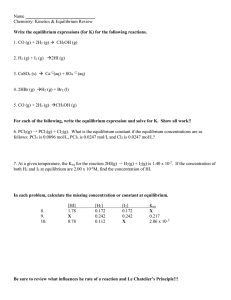Syracuse University Project Advance Exam #1, Spring 2014
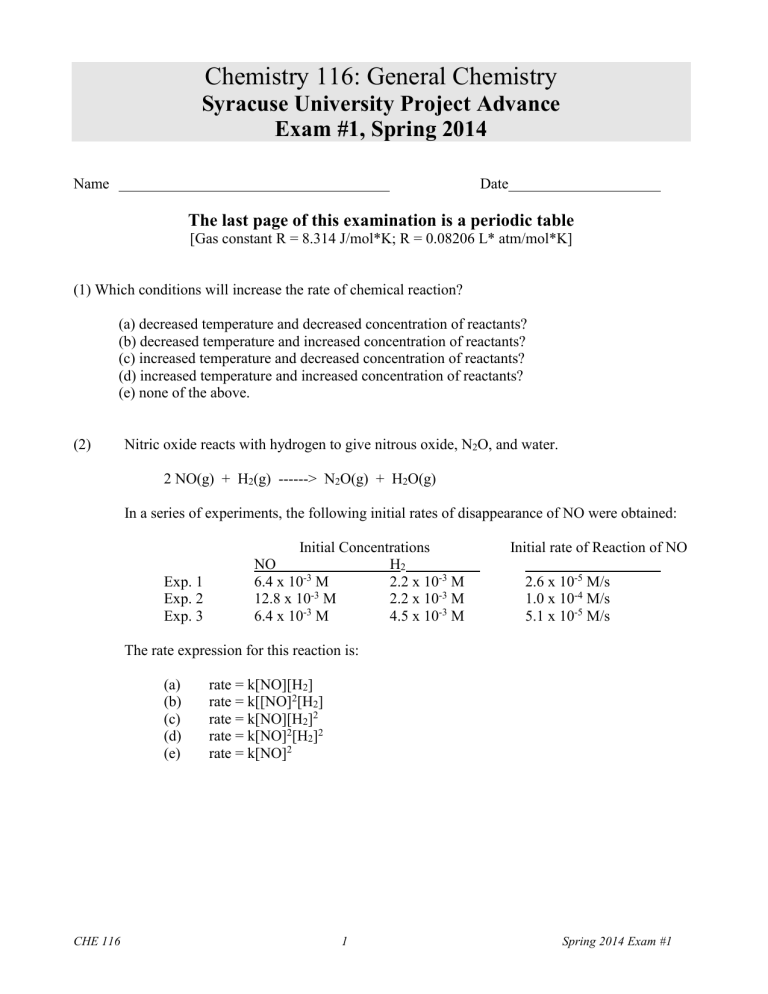
Chemistry 116: General Chemistry
Syracuse University Project Advance
Exam #1, Spring 2014
Name Date
The last page of this examination is a periodic table
[Gas constant R = 8.314 J/mol*K; R = 0.08206 L* atm/mol*K]
(1) Which conditions will increase the rate of chemical reaction?
(a) decreased temperature and decreased concentration of reactants?
(b) decreased temperature and increased concentration of reactants?
(c) increased temperature and decreased concentration of reactants?
(d) increased temperature and increased concentration of reactants?
(e) none of the above.
(2) Nitric oxide reacts with hydrogen to give nitrous oxide, N
2
O, and water.
2 NO(g) + H
Exp. 1
Exp. 2
Exp. 3
2
(g) ------> N
In a series of experiments, the following initial rates of disappearance of NO were obtained:
NO
2
O(g) + H
2
O(g)
Initial Concentrations
6.4 x 10 -3 M
12.8 x 10 -3 M
6.4 x 10 -3 M
H
2
2.2 x 10 -3 M
2.2 x 10 -3 M
4.5 x 10 -3 M
Initial rate of Reaction of NO
2.6 x 10 -5 M/s
1.0 x 10 -4 M/s
5.1 x 10 -5 M/s
The rate expression for this reaction is:
(a)
(b)
(c) rate = k[NO][H rate = k[[NO]
(d) rate = k[NO] 2
(e) rate = k[NO] 2
2
2
]
[H
2
] rate = k[NO][H
2
]
[H
2
]
2
2
CHE 116 1 Spring 2014 Exam #1
(3) A chemical reaction that is first order in x is observed to have a rate constant of 1.2 x 10
If the initial concentration of x is 2.0 M, what is the concentration of x after 200 s?
-2 s -1 .
(5)
(a) 0.18M
(b) 0.55M
(c) 1.0M
(d) 6.0 x 10 -3
(e) 1.7M
M
(4) A first-order chemical reaction is observed to have a rate constant of 35/min. What is the corresponding half-life for the reaction?
(a) 18 min.
(b) 20 min.
(c) 3.2 s
(d) 1.2 s
(e) 0.83 s
For the decomposition of one mole of nitrosyl chloride,
NOCl(g) ------> NO(g) +
The activation energy for this reaction is 100 kJ. The activation energy for the reverse reaction is
1 /
2
Cl
2
H = 38 kJ.
(a)
(b)
(c)
(d)
(e)
38 kJ
62 kJ
76 kJ
100 kJ
138 kJ
(6) The complete mechanism for a reaction is considered to occur in two steps, one which is slow and the other fast.
A + B ------> C + D
A + C ------> E + F slow fast
The rate expression for the overall reaction is
(a) k[A][B]
(b) k[A][B][C]
(c) k[A] 2 [B][C]
(d) k[A][C]
(e) Not enough information is provided to answer the question.
CHE 116 2 Spring 2014 Exam #1
(7) At 400° C the rate constant for the second order reaction 2A B + C is
1.2 x 10 -2 L/mol - sec. Given an initial concentration of 0.045 mol/L, what is the concentration of A after 30 minutes?
(8)
(a)
(e)
1.9 x 10 -11 mol/L
(b) 0.023 mol/L
(c) 0.031 mol/L
(d) 0.037 mol/L
0.044 mol/L
For the second order reaction 2A B + C with a rate constant of 1.2 x 10 -2 L/mol s, calculate the half-life when the initial concentration is 0.30 mol/L.
(a)
(b)
(c)
(d)
(e)
0.0011 s
25 s
58 s
4.6 m
7.2 m
(9) Consider the oxidation of SO
2
(g) to form SO
3
(g) in the presence of NO(g):
Eqn. 1
Eqn. 2
O
2
(g) + 2 NO(g) ------> 2 NO
2 NO
2
(g) + 2 SO
2
2
(g)
(g) ------> 2 NO(g) + 2 SO
3
(g)
With the Net Equation:
Eqn. 3 2SO
2
(g) + O
2
(g) ------> 2 SO
3
(g)
Which of the following is a reaction intermediate?
(a)
(b)
(c)
(d)
(e)
O
2
NO
NO
SO
SO
2
2
3
CHE 116 3 Spring 2014 Exam #1
(10) Consider the first-order reaction for the decomposition of sulfuryl chloride gas, SO
2
Cl
2
(g)
SO
2
Cl
2
(g) ------> SO
2
(g) + Cl
2
(g)
If it takes 6.30 x 10 4 seconds for 74% of the sample of SO
2
Cl
2
(g) to decompose at 320° C, what is the rate constant for this reaction at 320°C?
(a)
(b)
2.14 x 10
1.10 x 10
-5
-5
/s
/s
(c) 4.36 x 10 -4 /s
(d) 2.18 x 10 -4 /s
(e) none of the above
(11) In which reaction will the point of equilibrium shift to the left when the pressure on the system is increased?
(a) C(s) + O
2
(g) <------> CO
2
(g)
(b) CaCO
3
(s) <------> CaO(s) + CO
2
(g)
(c) 2Mg(s) + O
2
(g) <------> 2MgO(s)
(d) 2H
2
(g) + O
2
(g) <------> 2H
2
O(g)
(12) At a given temperature, the reaction shown below is at equilibrium when [CS
2
] = 0.050 M,
[Cl
2
] = 0.25 M, [CCl
4
] = 0.15 M, and [S
2
Cl
2
] = 0.35 M. What would be the direction of the reaction when the reactants and products have the following concentrations: [CS
2
] = 0.15 M,
[Cl
2
] = 0.20 M, [CCl
4
] = 0.30 M, and [S
2
Cl
2
] = 0.28M?
CS
(a)
(d)
2
(g) + 3Cl
2
(g) <======> CCl to the right
(b) to the left
(c) no change
4
(g) + S
2
Cl
2
(g) cannot predict unless we know the temperature
(e) cannot predict unless we know whether the reaction is exo- or endothermic.
CHE 116 4 Spring 2014 Exam #1
(13) Given the equilibrium shown below, the concentration of SO
2
at equilibrium will be decreased by
SO
2
Cl
2
(g) <======> SO
2
(g) + Cl
2
(g) H = +67 kJ
(a) adding Cl
2
to the system.
(b) increasing the temperature.
(c) adding SO
2
Cl
2
to the system.
(d)
(e) increasing the volume of the reaction vessel. adding helium to the reaction vessel.
(14) For the reaction:
CHCl
3
(g) + Cl
2
(g) ------> CCl
4
(g) + HCl(g)
The rate of reaction is given by: rate k[CHCl this reaction is:
3
(g)][Cl
2
(g)] 1/2 . The overall reaction order of
(a)
(b)
0
1
(c) 1 1/2
(d) 2
(e) 2 1/2
(15) Consider the reaction:
N
2
(g) + O
2
(g) <=====> 2NO(g) K
The given value of K c c
= 4.6 x 10 -31
(a) greatly favors product
(b) greatly favor reactants
(c) greatly favors neither
(d) can’t determine from the data given
CHE 116 5 Spring 2014 Exam #1
(16) Carbon disulfide and chlorine react according to the following equation:
CS
2
(g) + 3 Cl
2
(g) <======> S
2
Cl
2
(g) + CCl
4
(g)
When 1.00 mol of CS to equilibrium, the mixture is found to contain 0.250 mol of CCl
4
. What is the amount of Cl
2 at equilibrium?
2
and 3.00 mol of Cl
2
are placed in a 2 L container and allowed to come
(a)
(b)
0.25 mol
0.50 mol
(c) 0.75 mol
(d) 2.25 mol
(e) 2.75 mol
(17) Methanol is manufactured industrially by the reaction:
CO(g) + 2 H
2
(g) <======> CH
3
OH(g) K c
= 10.5 at 500K
Using the information for this reaction, what is the equilibrium constant for the related reaction:
2 CO(g) + 4 H
2
(g) <======> 2 CH
3
OH(g) K c
= ? at 500K
(a) 10.5
(b) 21.0
(c) 5.25
(d) 110
(e) 3.25
CHE 116 6 Spring 2014 Exam #1
(18) Phosgene, COCl
2
, dissociates at high temperature. In an experiment, 1.00 mole of phosgene is placed in a 25.0 Liter vessel, and the system is allowed to reach equilibrium.
COCl
2
(g) CO (g) + Cl
2
(g)
K c
= 8.05 x 10 equilibrium?
-4 at 400 o C for this reaction. What is the concentration of phosgene at
(a) 5.29 x 10 -3 M
(b) 6.09 x 10 -3 M
(c) 3.39 x 10 -2 M
(d) 3.47 x 10 -2 M
(e) 4.00 x 10 -2 M
(19) Consider the reaction at equilibrium
PCl
3
(g) + Cl
2
(g) <======> PCl
5
(g)
If Cl
2
(g) is removed from an equilibrium mixture of these gases,
(a) the reaction shifts to the left (more reactants)
(b) the reaction shifts to the right (more product)
(c) the reaction is unaffected since H < 0
(d) not enough information is provided to answer the question
(20) The rate constant for a reaction is 1.5 x 10 -2 sec -1 at 502 o C, and 3.5 x 10 -2 sec -1 at 552 o C.
What is the activation energy?
(a) 40 kJ
(b) 90 kJ
(c) 120 kJ
(d) 160 kJ
(e) 180 kJ
CHE 116 7 Spring 2014 Exam #1
Extra Credit: Explain and show all work.
EC1) The rate for a particular reaction is k[A][B] 2 . If the initial concentration of B increases from 0.1
M to 0.3 M, by which factor does the initial rate increase?
EC2) Consider the following reaction which is involved in the catalytic destruction of ozone by chlorine atoms:
O
2
(g).
ClO(g) + O
Kp = 2.5 x 10 6
3
(g) <======> Cl(g) + 2O
2
(g)
atm at 25° C. In an experiment at 25° C, ClO(g) at 1.0 x 10 -3 atm was mixed with O
3
(g) at 2.0 x 10 -5 atm in a rigid vessel. Calculate the equilibrium pressure of O
3
(g) and
CHE 116 8 Spring 2014 Exam #1

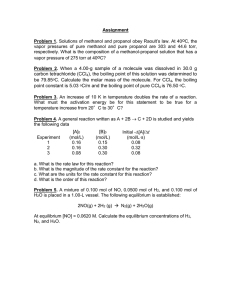
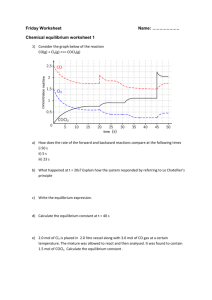
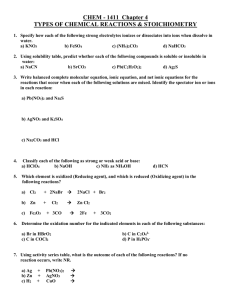
![CHEM 1520 SI MON, TUES, & WEDNES 1.Calculate [H3O+] in a](http://s3.studylib.net/store/data/007346334_1-b78d73402f58153c92290299886ff084-300x300.png)

